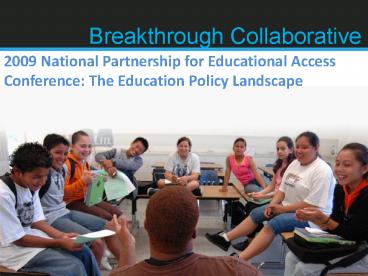Breakthrough Collaborative - PowerPoint PPT Presentation
1 / 22
Title:
Breakthrough Collaborative
Description:
... Gates Education ... Seattle, WA: Bill & Melinda Gates Foundation, 2003. Low income. Middle ... Obama's Vision for Education Reform. Investing in early ... – PowerPoint PPT presentation
Number of Views:45
Avg rating:3.0/5.0
Title: Breakthrough Collaborative
1
Breakthrough Collaborative
2009 National Partnership for Educational Access
Conference The Education Policy Landscape
2
Breakthrough Collaborative Mission Statement
Founded in San Francisco in 1978, Breakthrough
Collaborative is a national non-pro?t with a
mission to increase educational opportunity for
high-potential, disadvantaged middle-school
students and to inspire outstanding college and
high school students to pursue careers in
education.
3
What We Do-Students
- Breakthrough launches low-income students on the
road to college by providing - 6-year, year-round program including an intensive
six-week summer program and after-school and
weekend school-year programs - Tuition-free academically rigorous curriculum
- 41 student-teacher ratio overall (101 in
classroom) - Individual counseling
- College and high-school-aged mentors
- An environment where its cool to be smart
4
What We Do-Teachers
- Breakthrough challenges talented young people to
become educational leaders. Under the mentorship
of experienced educators, Breakthrough teachers - Lead every aspect of the program
- Implement curriculum
- Create lesson plans
- Grade papers
- Personally connect with their students and
function as positive role models and mentors
5
Breakthroughs Goals
- Ensure middle-school student successAll
Breakthrough middle-school students enter a
rigorous college prep high school program. - Support college readinessAll Breakthrough
students succeed in rigorous college prep high
school programs. At least 85 of our students
enroll in 4 year colleges - Develop leaders in educationBreakthroughs
teachers are well-trained and supported and are
more likely to become professional teachers and
leaders in education.
6
Who We Are
- Breakthrough collaborative at a glance
7
Student Profile
Breakthrough students are academically motivated
middle- and high-school students who demonstrate
need for the Breakthrough program.
92 students of color
65 qualify for free or reduced lunch
58 would be 1st in family to attend college
39 live in single-parent households
34 speak English as a second language
8
Why Breakthrough?
- A child from the bottom income quartile is 5
times less likely to earn a bachelors degree by
age 24 than is a child from a family in the top
income quartile.
SourceMortenson, T. (2001b, Oct.). Graph
titled BA attainment by age 24 by family income
quartile. Postsecondary Education Opportunity
9
Why Breakthrough?
Highest-performing low-income students graduate
from college at about the same rate as the
lowest-achieving high-income students
Percentage of 1988 8th graders who completed a
bachelors degree or higher by 2000
8th grade mathematics achievement
Source NCES, The Condition of Education, 2003,
Table 22-2
10
Why Breakthrough?
BA degree completion increases when students have
a strong high-school curriculum, particularly for
low-income students.
But low-income students are less likely to be
enrolled in a college prep curriculum.
11
Why Breakthrough?
Percentage of students enrolled in a college
prep program
Low income
Middle income
High income
Source Gates Education Policy Paper. Closing the
graduation gap Toward high schools that prepare
all students for college, work and citizenship.
Seattle, WA Bill Melinda Gates Foundation,
2003.
12
Goals for Today
- Increase knowledge about legislation that may
impact our programs - Learn from each other about strategies to
influence policy - Connect with colleagues who may be interested in
collaborating around policy advocacy
13
Federal policies/legislation
- American Recovery Reinvestment Act (ARRA)
- College Access
- Extended Learning Opportunities
- National Service
14
Obamas Vision for Education Reform
- Investing in early childhood education
- Improving standards assessments
- Recruiting, preparing rewarding outstanding
teachers - Promoting innovation excellence (including
charter schools effective extended learning
opportunities) - Providing every American with quality higher
education
15
Federal policies/legislation
- American Recovery Reinvestment Act (ARRA)
- Focused on four reform areas
- Improving teacher effectiveness equitable
teacher distribution - Improving data collection use
- Adopting rigorous college- and career-ready
standards and improving assessments - Turning around struggling schools
16
Federal policies/legislation
- American Recovery Reinvestment Act (ARRA)
- Several streams of funding, including
- Title I
- Youth Employment Training (WIA)
- Innovation Fund or What Works Fund
(competitive grants) - State Incentive Grants or Race to the Top
(competitive grants)
17
Federal policies/legislation
- College Access
- Highest of college graduates by 2020
- Higher Education Tax Credits Increased Pell
Grants in ARRA FY 2010 Budget Proposal - Access Completion Incentive Fund in FY 2010
Budget Proposal - Increase participation in AP classes, IB classes,
dual enrollment - Make College a Reality
Initiative potential use of ARRA funds
18
Federal policies/legislation
- Extended Learning Opportunities
- Potential use of ARRA funds
- 21st Century Community Learning Centers
- STEP UP
19
Federal policies/legislation
- National Service Serve America Act
- Triples the number of volunteers
- Increases education award to 5350
- Education Corps
- Community-based service learning, including
Summer of Service/Semester of Service - Social Innovation Fund
- Nonprofit Capacity Building Grants
- Volunteer Generation Fund
20
Other federal policy/legislation or state level
policy/legislation that may impact your programs?
21
- Which of these policies/legislation has the most
relevance/potential impact for your program and
why? - What strategies have you used or would you want
to use to influence this policy issue? - Are there opportunities to collaborate around
this policy issue?
22
Elisabeth Cutlerecutler_at_breakthroughcollaborative
.org415-442-0600 ext 131































